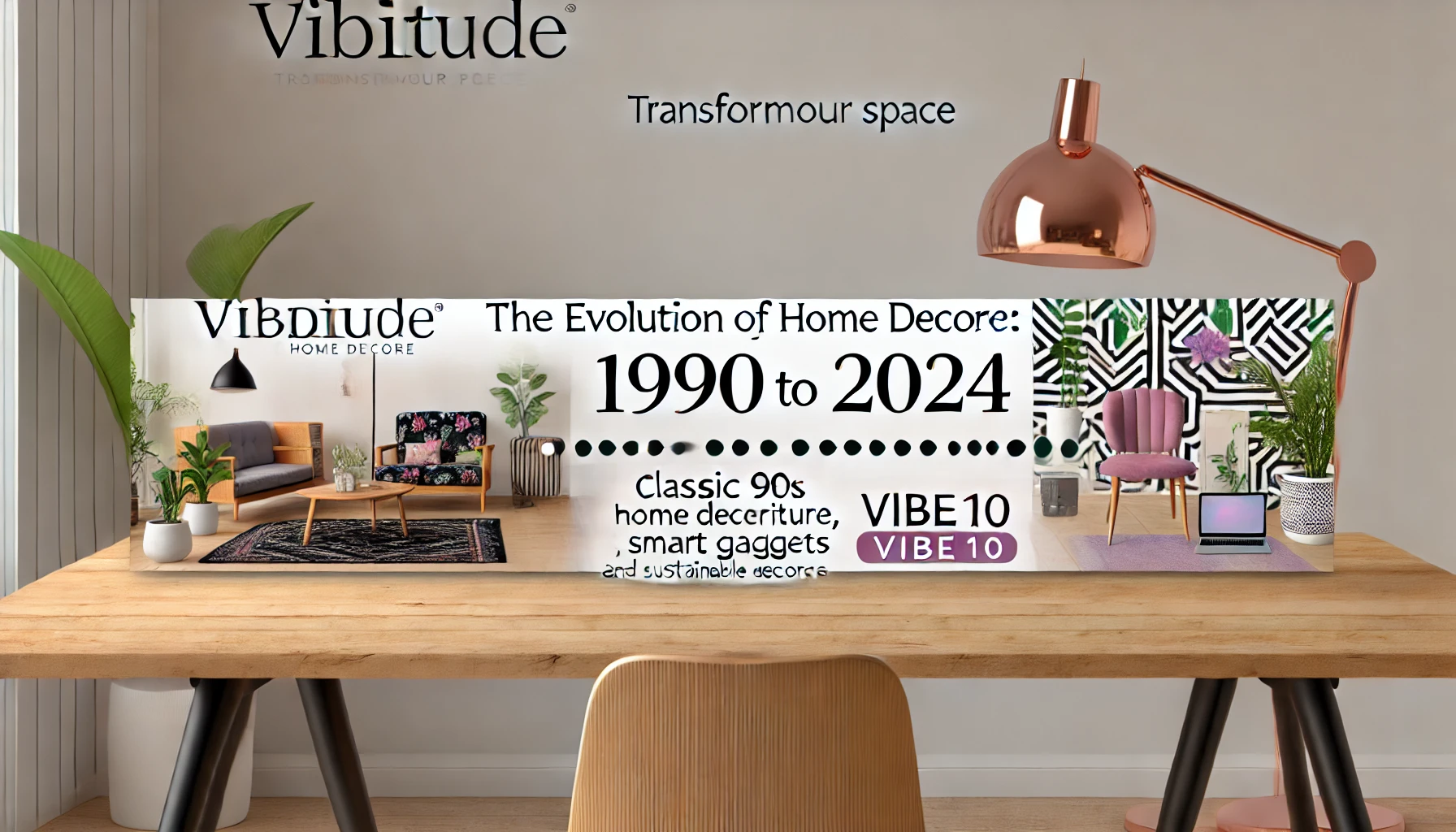Home décor has always been an essential aspect of human expression, reflecting not just personal tastes but also cultural and technological shifts. From the functional and modest designs of the 1990s to the high-tech and eco-conscious trends of 2024, the journey of home décor over the past three decades is fascinating. This blog explores how home décor has evolved, shaped by societal trends, technological innovations, and environmental awareness.

The 1990s: Functionality Meets Simplicity
The 1990s were characterized by functional, practical home décor with a touch of coziness. People prioritized comfort and durability over aesthetics, with an emphasis on creating spaces that felt like home.
Key Trends in the 1990s:
- Neutral Color Palettes:
Beige, white, and pastel tones dominated, creating a calm and inviting atmosphere. - Heavy Furniture:
Bulky wooden furniture, often featuring intricate carvings, was popular, reflecting traditional craftsmanship. - Patterned Upholstery:
Sofas and curtains often had floral or geometric patterns, adding personality to otherwise neutral rooms. - Wall-to-Wall Carpeting:
Carpeting was a symbol of luxury and comfort, with muted colors to complement the overall theme. - Minimal Technology Integration:
Décor focused on aesthetics, with minimal interference from technology. Televisions and stereos were large and often hidden in cabinets.
The 2000s: The Rise of Modern Minimalism
The turn of the millennium brought a shift toward sleek and modern designs. As technology became more integrated into daily life, it also influenced home décor.
Key Trends in the 2000s:
- Modern Minimalism:
Clean lines, open spaces, and a clutter-free look became the hallmark of modern homes. Furniture designs emphasized simplicity and functionality. - Neutral with Bold Accents:
While neutral tones remained dominant, bold accents like red, black, or metallics added a contemporary edge. - Multi-Functional Spaces:
Open floor plans became common, merging living rooms and kitchens to create seamless, multi-functional areas. - Glass and Metal Elements:
Materials like glass, steel, and chrome were widely used, adding a futuristic vibe. - Technological Integration:
Flat-screen TVs and home entertainment systems became centerpieces, reflecting the growing importance of tech in everyday life.
The 2010s: Personalization and Global Influence
The 2010s marked an era of personalization and global influences in home décor. People began incorporating their unique styles while drawing inspiration from international trends.
Key Trends in the 2010s:
- Eclectic Aesthetic:
Mixing and matching different styles, such as rustic, industrial, and bohemian, allowed for more personalized spaces. - DIY and Upcycling:
The rise of Pinterest and Instagram inspired homeowners to engage in DIY projects and repurpose old furniture for a more sustainable approach. - Scandinavian Design:
Hygge, the Danish concept of coziness, popularized minimalistic yet warm designs with natural materials and soft textures. - Smart Homes:
The introduction of smart devices like Alexa, Google Home, and smart lighting systems began to revolutionize living spaces. - Indoor Plants:
Biophilic design, emphasizing greenery and natural elements, gained popularity for its calming effects and aesthetic appeal.
2020 and Beyond: Sustainability and High-Tech Living
As the world faced unprecedented challenges, including the COVID-19 pandemic, home décor evolved to meet new demands for comfort, functionality, and sustainability. From 2020 to 2024, homes became multi-purpose sanctuaries, blending work, leisure, and wellness.
Key Trends in the 2020s:
- Sustainable Décor:
Eco-conscious choices dominate the scene. Recycled materials, energy-efficient designs, and sustainable furniture are now essentials for modern homes. - Smart Living Spaces:
The rise of AI-powered home automation systems has transformed how people interact with their homes. Features like voice-controlled lighting, smart thermostats, and security systems are standard. - Multi-Purpose Furniture:
With remote work becoming a norm, furniture that serves multiple purposes—such as sofa beds and expandable tables—has gained popularity. - Earthy and Muted Tones:
Earthy tones like terracotta, sage green, and beige reflect a growing connection to nature. - Artisanal and Handmade Pieces:
As a counterbalance to high-tech living, people increasingly value artisanal craftsmanship and handmade décor items. - Compact Living Solutions:
Urbanization has led to smaller living spaces, making compact and modular furniture essential for functionality without compromising on style.
Top Influences on Home Décor Evolution
1. Technology:
From bulky electronics in the 1990s to sleek, integrated systems in 2024, technology has played a pivotal role in shaping home décor trends.
2. Sustainability:
Awareness of environmental issues has driven a shift toward eco-friendly materials and energy-efficient designs.
3. Globalization:
The ability to draw inspiration from diverse cultures has enriched home décor with unique patterns, textures, and ideas.
4. Social Media:
Platforms like Instagram, Pinterest, and YouTube have democratized interior design, making trends more accessible and inspiring creativity.
5. Lifestyle Changes:
The rise of remote work, wellness trends, and urban living has influenced furniture design, color palettes, and overall home functionality.
How to Incorporate 2024’s Home Décor Trends
- Embrace Smart Technology:
Invest in smart devices that enhance convenience and energy efficiency. - Opt for Sustainable Choices:
Choose furniture made from recycled or eco-friendly materials to create a greener home. - Personalize Your Space:
Mix styles, add unique vintage pieces, and display personal items to make your home truly yours. - Add Greenery:
Indoor plants not only beautify spaces but also improve air quality and create a calming environment. - Focus on Multi-Functionality:
Look for furniture and layouts that serve multiple purposes, especially in smaller spaces.
The Future of Home Décor
As we look beyond 2024, the focus on sustainability, technology, and personalization is set to deepen. Homes will continue to reflect the changing world, combining innovation with comfort and style.
Final Thoughts
The journey of home décor from 1990 to 2024 showcases humanity’s evolving needs and aspirations. From functional simplicity to tech-powered sustainability, every decade brought something unique. Whether you’re drawn to the rustic charm of the past or the sleek designs of the future, there’s no better time to embrace the trends that resonate with your personal style.
Discover timeless pieces and modern innovations to elevate your space—because your home should be as dynamic and unique as you are!

